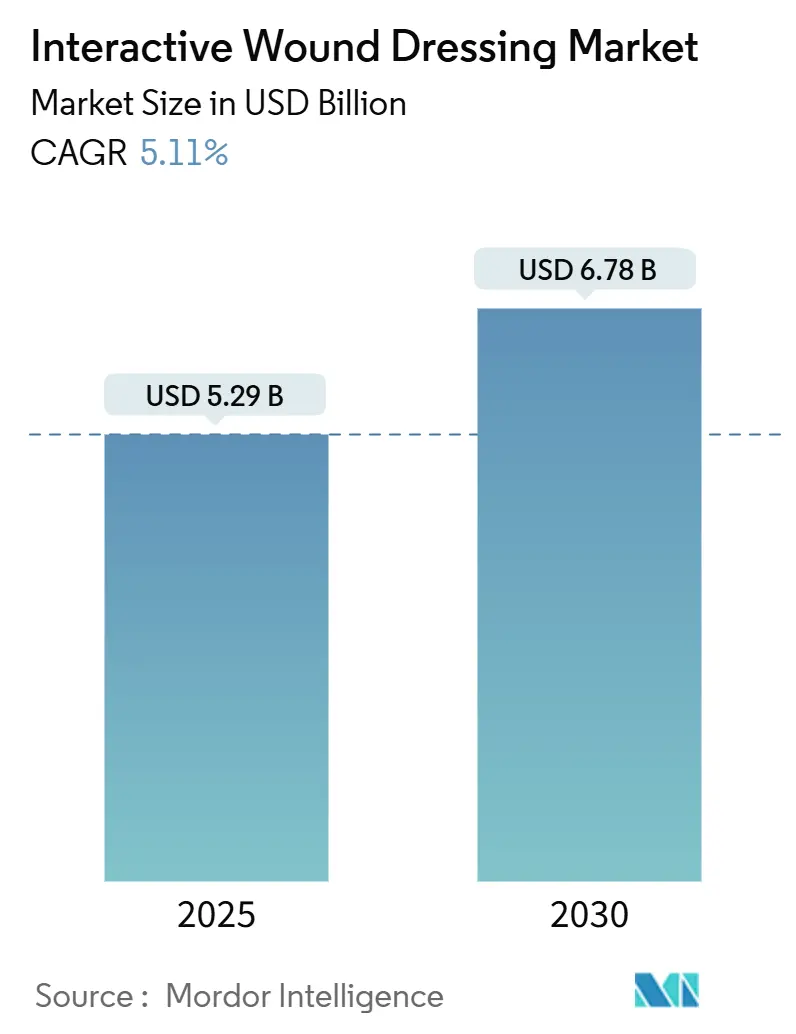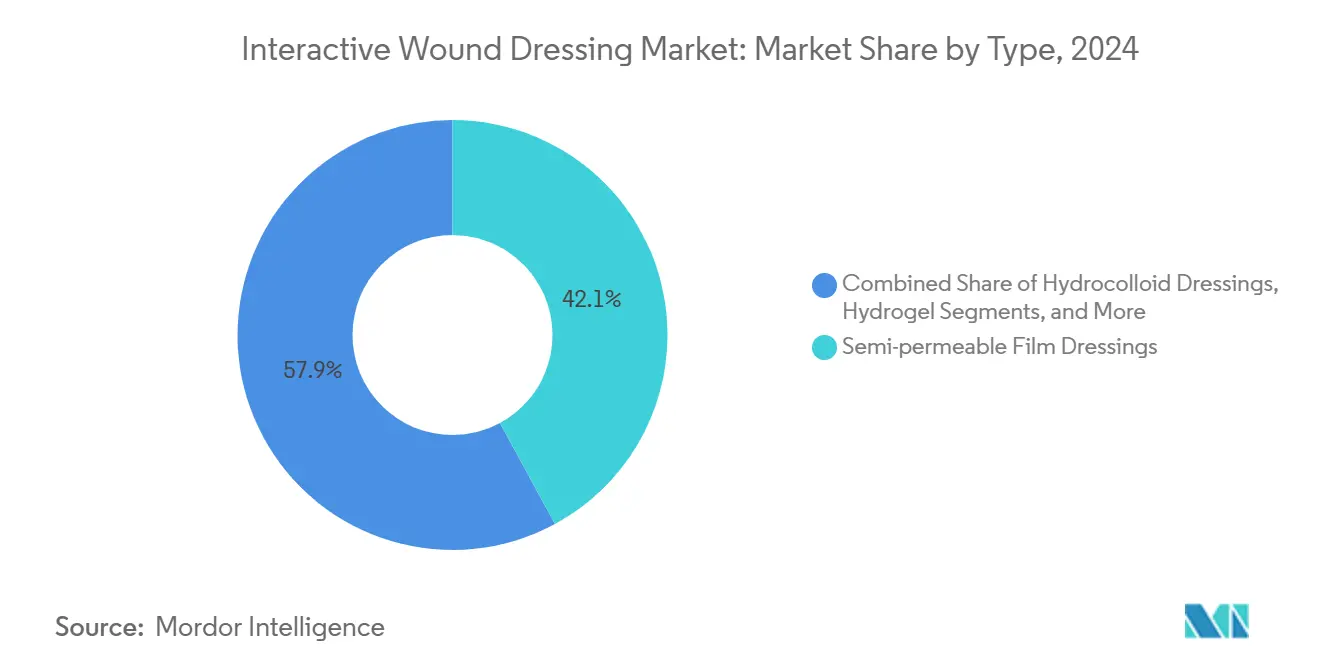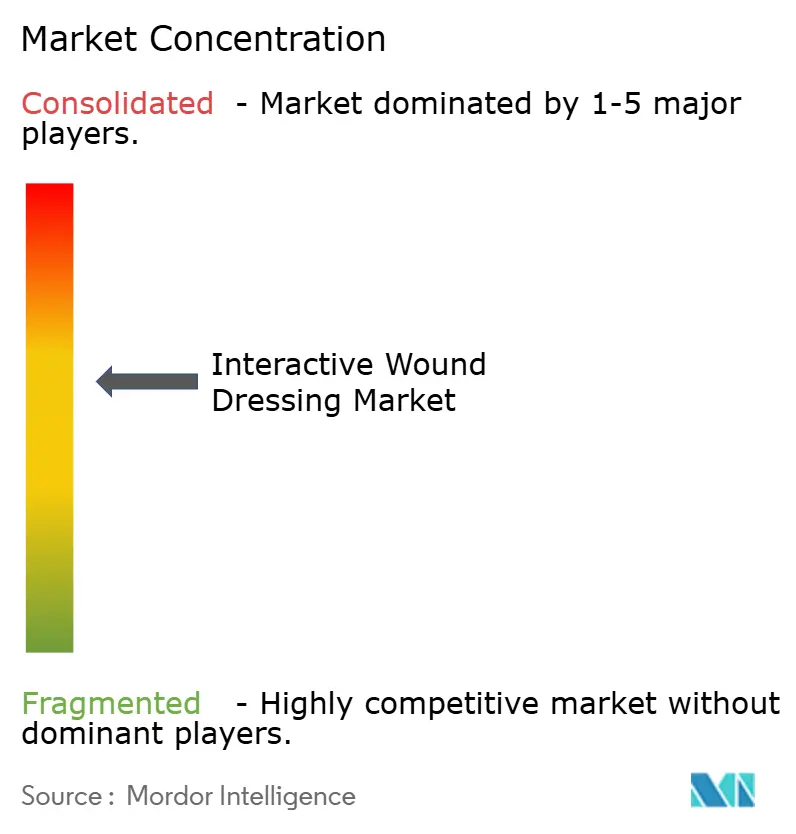Interactive Wound Dressing Market Size and Share

Interactive Wound Dressing Market Analysis by Mordor Intelligence
The interactive wound dressing market reached USD 5.29 billion in 2025 and is on course to expand to USD 6.78 billion by 2030, recording a 5.11% CAGR. Technical advances that merge biosensors with conventional dressings now enable wireless monitoring and active therapeutic delivery, shortening average healing forecasts by up to 14 days compared with visual assessment alone. Hospitals continue to adopt these devices for hard-to-heal ulcers, while new telehealth reimbursement policies drive uptake in home care settings. Supply-chain pressures on polyurethane and silicone foam have raised production costs, yet manufacturers offset this with premium pricing for sensor-enabled dressings that demonstrate superior outcomes. Consolidation among leading brands, highlighted by Coloplast’s purchase of Kerecis and 3M’s recent wound-care spin-off, positions diversified platforms to capture the next wave of growth.
Key Report Takeaways
- By product type, semi-permeable film dressings led with 42.14% of the interactive wound dressing market share in 2024, while hydrogel dressings are set to grow fastest at a 5.98% CAGR to 2030.
- By application, chronic wounds accounted for 59.87% share of the interactive wound dressing market size in 2024; acute wounds are projected to expand at a 6.12% CAGR through 2030.
- By technology, passive interactive dressings held 68.95% share in 2024, whereas smart connected dressings are advancing at a 6.23% CAGR to 2030.
- By end-user, hospitals and clinics captured 55.83% revenue in 2024, yet home healthcare demand is rising at a 6.04% CAGR on the back of caregiver training incentives.
- Geographically, North America retained 43.17% market share in 2024, while Asia-Pacific is forecast to register the fastest regional CAGR of 6.31% to 2030.
Global Interactive Wound Dressing Market Trends and Insights
Drivers Impact Analysis
| Driver | (~) % Impact on CAGR Forecast | Geographic Relevance | Impact Timeline |
|---|---|---|---|
| Growing incidence of pressure ulcers & diabetic foot | +1.2% | Global, concentrated in North America & Europe | Long term (≥ 4 years) |
| Rising volume of surgical procedures | +0.9% | Global, led by Asia-Pacific growth | Medium term (2-4 years) |
| Rapid technology upgrades in interactive dressings | +1.5% | North America & EU, expanding to APAC | Short term (≤ 2 years) |
| Smart bio-electronic dressings securing new CPT codes | +0.8% | North America, with EU regulatory alignment | Medium term (2-4 years) |
| Home-based chronic-wound reimbursement incentives | +0.7% | North America, selective EU markets | Short term (≤ 2 years) |
| Boom in APAC ambulatory wound-care clinics | +1.1% | Asia-Pacific core, spill-over to MEA | Long term (≥ 4 years) |
| Source: Mordor Intelligence | |||
Growing Incidence of Pressure Ulcers & Diabetic Foot
Diabetic foot ulcers affect more than 40 million people worldwide and cost the United States healthcare system USD 28 billion each year. Interactive dressings that read pH and temperature detect infection up to 72 hours earlier than visual checks, enabling 95% wound-area reduction in 14 days versus 89.7% with standard care [1]MDPI, “Smart sensor dressings accelerate chronic-wound closure,” mdpi.com. Machine-learning models built into these devices now predict closure outcomes with 98% accuracy, framing a shift toward predictive medicine that lowers readmissions and amputations. The positive clinical-economic profile reinforces premium reimbursement, boosting adoption across the interactive wound dressing market.
Rapid Technology Upgrades in Interactive Dressings
Water-powered electronics-free dressings generate therapeutic electric fields that accelerate closure by 30% at a cost of USD 2 per unit. Flexible laser-induced graphene sensors measure both strain and temperature with 0.5 °C sensitivity, giving clinicians granular insight without disturbing the wound. Microneedle-iontophoresis patches enhance drug penetration and dampen inflammation, reducing nitric-oxide buildup and cytokine expression in vivo. Such breakthroughs recast dressings from commodity disposables into therapeutic devices, reinforcing value capture in the interactive wound dressing market.
Smart Bio-Electronic Dressings Securing New CPT Codes
The FDA classified sensor dressings that monitor bacterial protease as Class II devices effective June 2025, opening pathways for differentiated reimbursement. The CY 2025 Medicare Physician Fee Schedule introduces codes that pay for remote caregiver training, catalyzing supplier partnerships with telehealth platforms. Instance approvals such as AOTI’s device expansion and SolasCure’s Fast-Track status confirm regulator confidence in bio-interactive therapies. Coding clarity supports wider clinical uptake and underpins revenue growth throughout the interactive wound dressing market.
Boom in APAC Ambulatory Wound-Care Clinics
Community clinics across China deliver standardized chronic-wound protocols that combine compression, education, and sensor-enabled dressings, cutting average inpatient stays to 3.72 days with 91.85% satisfaction. Telemedicine links maintain follow-up visits while slashing utilization by 50%. Asia’s manufacturing edge in bandages lowers cost barriers, turning the region into both a supply hub and the fastest-growing demand center within the interactive wound dressing market.
Restraints Impact Analysis
| Restraint | (~) % Impact on CAGR Forecast | Geographic Relevance | Impact Timeline |
|---|---|---|---|
| High cost of advanced dressings | -1.3% | Global, acute in emerging markets | Medium term (2-4 years) |
| Stringent multi-region regulatory pathways | -0.8% | Global, concentrated in North America & EU | Long term (≥ 4 years) |
| Polyurethane & silicone foam supply shortages | -0.7% | Global, severe in North America & Europe | Short term (≤ 2 years) |
| Data-security liability for sensor-enabled dressings | -0.5% | North America & EU, expanding to APAC | Medium term (2-4 years) |
| Source: Mordor Intelligence | |||
High Cost of Advanced Dressings
Bioengineered skin substitutes can push single-patient claims beyond USD 1 million, limiting access in lower-income regions. Geopolitical shocks raised specialty material costs, pushing device manufacturing overheads to 20% of revenue by late-2024[2]Medical Technology, “Geopolitical pressures elevate device manufacturing costs,” medicaltechnology.com. In Australia, fewer than 200 patients benefit from subsidy schemes despite 400,000 chronic wound sufferers each year, forcing households into out-of-pocket purchases. Still, model studies predict system savings of 15% when sensor dressings prevent complications, a message that may unlock broader coverage and sustain growth across the interactive wound dressing market.
Stringent Multi-Region Regulatory Pathways
An FDA proposal from November 2023 would elevate many antimicrobial dressings from Class I to Class II or III, adding rigorous biocompatibility and performance trials. Concurrent CMS rules cap reimbursable applications for tissue-based products to eight over 16 weeks and demand 50% area-reduction proof, lifting documentation overhead for providers. Smaller firms must now fund parallel submissions in the United States, Europe, and key Asian markets, delaying launch schedules and compressing margins within the interactive wound dressing market.
Segment Analysis
By Type: Film Dressings Lead While Hydrogels Drive Innovation
Semi-permeable films retained 42.14% of the interactive wound dressing market in 2024, prized for transparency and minimal trauma during changes. Hydrogel formats hold the highest growth forecast at a 5.98% CAGR as stimuli-responsive polymers dose drugs when pH or glucose shifts. The interactive wound dressing market size for hydrogels is projected to reach USD 1.24 billion by 2030, confirming investor interest in adaptive biomaterials.
Hydrogels increasingly embed AI algorithms that trigger silver-ion release or hydration pulses when infection risk peaks, blending passive moisture control with active therapy. Films evolve too, integrating micro-perforations to balance vapor loss and exudate control in orthopedic surgery. Regulatory scrutiny of silver antimicrobials could redirect R&D budgets toward peptide coatings, but does not dampen demand for visual inspection benefits that keep film products central to the interactive wound dressing market.

Note: Segment shares of all individual segments available upon report purchase
By Application: Chronic Wounds Dominate as Acute Care Accelerates
Chronic wounds generated 59.87% of 2024 revenue as diabetic foot and pressure ulcers require months-long regimens. Acute wounds, however, are climbing at a 6.12% CAGR thanks to prophylactic adoption in cardiac, orthopedic, and obstetric theaters. The interactive wound dressing market size for acute wounds is expected to surpass USD 2.3 billion by 2030, mirroring hospitals’ focus on surgical site infection penalties.
Advanced hydrogel patches such as AMNIODERM+® trimmed wound areas by 95.5% over 12 weeks, with 65% of diabetics reaching full closure. For burns, sensor meshes capture moisture gradients, reducing painful re-dressing, while live feedback adjusts cooling. Pressure-redistributing foams transmit alerts when shear load rises, averting tissue necrosis. Together, these use cases extend market relevance beyond chronic care and cement long-run expansion for the interactive wound dressing market.
By End-User: Hospitals Lead While Home Care Transforms
Hospitals and clinics held 55.83% revenue in 2024, securing bulk contracts for complex cases requiring negative-pressure systems combined with interactive dressings. Home healthcare, supported by telemonitoring codes, is expanding at 6.04% CAGR as caregivers receive virtual training and sensor data uploads. The interactive wound dressing market share in home settings could top 30% by 2030 as payors reward avoided readmissions.
Ambulatory surgical centers leverage dressings that slash average stays to 3.72 days, freeing beds and improving patient satisfaction scores. Long-term care facilities deploy pressure-mapping foams to meet tougher hospital-acquired ulcer benchmarks. Remote dashboards let nursing agencies triage visits, reducing mileage while maintaining safety. These shifts distribute treatment beyond the ward, broadening penetration of the interactive wound dressing market.

Note: Segment shares of all individual segments available upon report purchase
By Technology: Passive Dressings Dominate as Smart Solutions Emerge
Passive interactive dressings still represented 68.95% of 2024 shipments, yet smart variants are rising 6.23% annually, capturing clinicians’ appetite for real-time analytics. The interactive wound dressing industry now straddles three tiers: passive barriers, bioactive matrices, and sensor-enabled systems.
Water-powered dressings create microcurrents without batteries, cutting costs for developing regions. Nanozyme-laden foams neutralize biofilms while reporting oxidative stress to a phone app, advancing infection control. Flexible printed circuits inside polyurethane layers send strain data to EHRs, closing the feedback loop between bedside and dashboard. As unit prices fall, smart formats will likely erode passive share, transforming competitive logic across the interactive wound dressing market.
Geography Analysis
North America kept 43.17% of 2024 sales, supported by Medicare coverage for lymphedema compression and new telehealth codes for caregiver training. FDA reclassification proposals raise compliance costs yet validate the clinical significance of antimicrobial and sensor-based products within the interactive wound dressing market. Smith+Nephew reported significant increase in Q1 2025 revenue growth in Advanced Wound Management following ALLEVYN Ag+ SURGICAL rollout, underscoring continued innovation [3]Smith+Nephew, “First-quarter 2025 trading statement,” smith-nephew.com.
Asia-Pacific, led by China, will record the fastest CAGR of 6.31% through 2030. National guidelines promote community-based chronic-wound programs that pair compression with smart bandages, while domestic manufacturing lowers acquisition prices. Exports of basic bandages finance R&D in bioactive foams, enabling regional suppliers to enter premium segments of the interactive wound dressing market. Telehealth apps bridge specialist gaps, cutting outpatient visits by 50%, which further entrenches sensor dressings in rural care protocols.
Europe shows steady momentum as aging demographics swell the chronic-wound pool. CE-mark rigor ensures quality and encourages multinational trials that quantify cost avoidance from early infection detection. Germany and the United Kingdom pilot reimbursement schemes for dressings with embedded analytics, rewarding total-cost savings over device price tags. Emerging economies in the Middle East, Africa, and Latin America adopt interactive dressings selectively, focusing on trauma centers and military medicine. However, inconsistent reimbursement and high import duties temper near-term scale, creating white-space for public-private partnerships to unlock latent demand across the interactive wound dressing market.

Competitive Landscape
Competition is moderate but intensifying as incumbents acquire niche innovators. 3M’s spun-off Solventum business combines negative-pressure systems with smart foams, while Coloplast absorbed Kerecis to secure fish-skin graft technology. Johnson & Johnson’s Ethicon unit pursues peptide coatings to sidestep impending antimicrobial rules, evidencing portfolio hedging. Emerging firms such as Vomaris deploy bioelectric fields that repel pathogens and accelerate epithelialization, challenging legacy silver platforms.
Regulatory clarification around Class II sensor dressings empowers premium pricing that offsets R&D overhead, but ramps the data-security burden for wireless platforms. Suppliers differentiate through cloud dashboards that integrate with hospital EHRs and insurer portals. Partnerships with telehealth providers convert dressings into service bundles, creating recurring revenue streams and anchoring customer loyalty within the interactive wound dressing market.
Raw-material volatility forces strategic stockpiling of polyurethane and silicone, prompting some manufacturers to vertically integrate foam production. Others outsource printing of flexible circuits to electronics partners to expedite scaling. The competitive field is thus splitting between full-stack device companies and ecosystem orchestrators that license sensing modules and analytics to multiple dressing brands.
Interactive Wound Dressing Industry Leaders
-
3M
-
B. Braun Melsungen AG
-
Cardinal Health, Inc
-
Smith & Nephew
-
Coloplast
- *Disclaimer: Major Players sorted in no particular order

Recent Industry Developments
- June 2022: Collagen Matrix, Inc. received 510(k) clearance for a fibrillar collagen wound dressing.
- June 2022: Smith & Nephew opened a USD 100 million R&D and manufacturing facility to bolster advanced wound management output.
Research Methodology Framework and Report Scope
Market Definitions and Key Coverage
Our study defines the interactive wound dressing market as all single-use or short-wear coverings that actively modulate moisture, temperature, or biochemistry at the wound bed through films, foams, hydrogels, hydrocolloids, alginates, collagen matrices, antimicrobial layers, or embedded sensors. These products are supplied to hospitals, ambulatory centers, and home-care providers and are valued at manufacturer-level revenues.
Exclusions: traditional dry gauze, negative-pressure systems, and large-format graft substitutes are outside scope.
Segmentation Overview
- By Type
- Semi-permeable Film Dressings
- Semi-permeable Foam Dressings
- Hydrogel Dressings
- Hydrocolloid Dressings
- Alginate Dressings
- Collagen-Matrix Dressings
- Antimicrobial Silver Dressings
- Smart Sensor-enabled Dressings
- Bioactive/Nanofiber Dressings
- By Application
- Acute Wounds
- Surgical & Traumatic Wounds
- Burns
- Chronic Wounds
- Diabetic Foot Ulcers
- Pressure Ulcers
- Venous Leg Ulcers
- Other Chronic Wounds
- Acute Wounds
- By End-User
- Hospitals & Clinics
- Ambulatory Surgical Centers
- Home Healthcare
- Others
- By Technology
- Passive Interactive Dressings
- Smart Connected Dressings
- Bioactive Dressings
- By Geography
- North America
- United States
- Canada
- Mexico
- Europe
- Germany
- United Kingdom
- France
- Italy
- Spain
- Rest of Europe
- Asia-Pacific
- China
- Japan
- India
- Australia
- South Korea
- Rest of Asia-Pacific
- Middle East & Africa
- GCC
- South Africa
- Rest of Middle East & Africa
- South America
- Brazil
- Argentina
- Rest of South America
- North America
Detailed Research Methodology and Data Validation
Primary Research
Analysts spoke with wound-care nurses, procurement leads at multi-facility hospital chains across North America, Europe, and Asia, plus product managers from dressing suppliers. Their insights on average change intervals, price dispersion, and smart-dressing uptake filled key data gaps and anchored our assumptions.
Desk Research
We began with global health statistics from bodies such as WHO, OECD, and CDC to size the diabetic and pressure-ulcer patient pools, then paired them with import-export codes drawn from Volza and customs dashboards that track polyurethane and alginate dressing flows. Company 10-Ks, FDA 510(k) clearances, and trade association briefs such as EWMA supplied unit launches, while patent mining on Questel revealed sensor adoption curves. D&B Hoovers supplemented revenue splits. Many other public and paid sources were also consulted for corroboration.
Market-Sizing & Forecasting
A top-down prevalence-to-treated-cohort build tracked chronic and acute wound episodes by region. Results were cross-checked against sampled average selling price multiplied by volume shipments reported by mid-tier suppliers to refine totals. Driver variables, including diabetes incidence, long-term care bed capacity, average wear days, reimbursement shifts, sensor penetration, and dressing ASP erosion, fed a multivariate regression that projects demand. Bottom-up roll-ups of select national tender data validated regional spreads, with missing volumes imputed from peer geographies bearing similar care pathways.
Data Validation & Update Cycle
Model outputs pass three-layer reviews: automated variance scans against historical ranges, analyst peer checks, and a senior sign-off. We refresh figures annually, issuing interim tweaks when policy, pricing, or recall events move the market materially, so clients receive our most current view.
Why Our Interactive Wound Dressing Baseline Commands Reliability
Published numbers often differ because firms mix traditional and interactive dressings, choose disparate sales channels, or freeze exchange rates at outdated points.
Key gap drivers include narrower product baskets, omission of home-care volumes, unverified ASP curves, and longer refresh gaps that dampen visibility into fast-rising smart dressings.
Benchmark comparison
| Market Size | Anonymized source | Primary gap driver |
|---|---|---|
| USD 5.29 B (2025) | Mordor Intelligence | |
| USD 4.30 B (2023) | Global Consultancy A | Scope limits to film, foam, hydrogel; excludes home-care sales |
| USD 4.67 B (2025) | Industry Advisor B | Relies on hospital invoices only, omits sensor dressings in tenders |
| USD 2.80 B (2023) | Trade Journal C | Uses acute wound cases without adjusting for advanced dressing uptake |
These comparisons show that once uniform scope, channels, and currency bases are applied, Mordor's disciplined mix of validated prevalence data and price-volume checks delivers a balanced, transparent baseline that decision-makers can trace back to clear, repeatable steps.
Key Questions Answered in the Report
What is the current Interactive Wound Dressing Market size?
The market is valued at USD 5.29 billion in 2025 and is on track to reach USD 6.78 billion by 2030.
Who are the key players in Interactive Wound Dressing Market?
3M, B. Braun Melsungen AG, Cardinal Health, Inc, Smith & Nephew and Coloplast are the major companies operating in the Interactive Wound Dressing Market.
Which is the fastest growing region in Interactive Wound Dressing Market?
Asia-Pacific is forecast to grow at a 6.31% CAGR to 2030, driven by China’s manufacturing capacity and a surge in ambulatory wound-care clinics.
Why are hydrogel dressings expected to grow faster than other formats?
Hydrogel products incorporate stimuli-responsive polymers that release therapy only when wound conditions change, supporting a 5.98% CAGR through 2030.
Which product type generates the largest revenue?
Semi-permeable film dressings hold the lead with 42.14% of global revenue in 2024.
Page last updated on:



